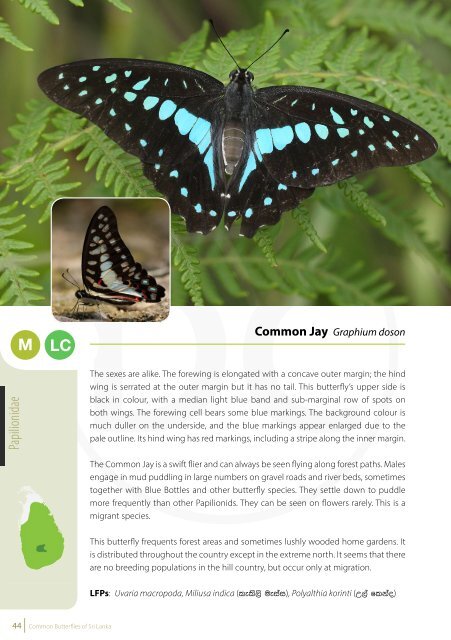Common Butterflies of Sri Lanka
Common Butterflies of Sri Lanka
Common Butterflies of Sri Lanka
You also want an ePaper? Increase the reach of your titles
YUMPU automatically turns print PDFs into web optimized ePapers that Google loves.
M<br />
LC<br />
<strong>Common</strong> Jay Graphium doson<br />
Tailed Jay Graphium agamemnon<br />
M<br />
LC<br />
Papilionidae<br />
The sexes are alike. The forewing is elongated with a concave outer margin; the hind<br />
wing is serrated at the outer margin but it has no tail. This butterfly’s upper side is<br />
black in colour, with a median light blue band and sub-marginal row <strong>of</strong> spots on<br />
both wings. The forewing cell bears some blue markings. The background colour is<br />
much duller on the underside, and the blue markings appear enlarged due to the<br />
pale outline. Its hind wing has red markings, including a stripe along the inner margin.<br />
The sexes are similar in pattern, but females have longer tails. The forewing is pointed<br />
and the outer margin is slightly serrated. The outer margin <strong>of</strong> the hind wing is clearly<br />
serrated, with a distinct tornal tail. It is dark brown in colour with green patches<br />
dispersed throughout. The patches are brighter towards the forewing base, and turn<br />
yellowish towards the outer margin <strong>of</strong> the hind wing. Its underside is pale brown and<br />
clouded with pale purplish tinged scales. The green patches are not prominent.<br />
Papilionidae<br />
The <strong>Common</strong> Jay is a swift flier and can always be seen flying along forest paths. Males<br />
engage in mud puddling in large numbers on gravel roads and river beds, sometimes<br />
together with Blue Bottles and other butterfly species. They settle down to puddle<br />
more frequently than other Papilionids. They can be seen on flowers rarely. This is a<br />
migrant species.<br />
This butterfly frequents forest areas and sometimes lushly wooded home gardens. It<br />
is distributed throughout the country except in the extreme north. It seems that there<br />
are no breeding populations in the hill country, but occur only at migration.<br />
LFPs: Uvaria macropoda, Miliusa indica (lels,s ueiai), Polyalthia korinti (W,a flkao)<br />
The habits <strong>of</strong> the Tailed Jay are very similar to those <strong>of</strong> the Blue Bottle, except that they<br />
only very rarely engage in mud puddling.<br />
It is common throughout the country in sparsely wooded areas, and wet habitats<br />
are not essential. It is quite unusual in forests, but can be found abundantly in home<br />
gardens where its larval food plants are grown for fruits. Lately, its numbers in the<br />
wet zone marshes have increased due to the propagation <strong>of</strong> the invasive alien plant<br />
species Annona glabra (fj,a wd;a;d).<br />
LFPs: It has nearly 20 species <strong>of</strong> larval food plants belonging to the family Annonaceae,<br />
ranging from planted species to forested species. These include: Polyalthia cerasoides<br />
(mÜg W,a flkao), Annona muricata (lgq wfkdaod), Xylopia championii (o;a leáh)<br />
44 <strong>Common</strong> <strong>Butterflies</strong> <strong>of</strong> <strong>Sri</strong> <strong>Lanka</strong><br />
<strong>Common</strong> <strong>Butterflies</strong> <strong>of</strong> <strong>Sri</strong> <strong>Lanka</strong> 45















